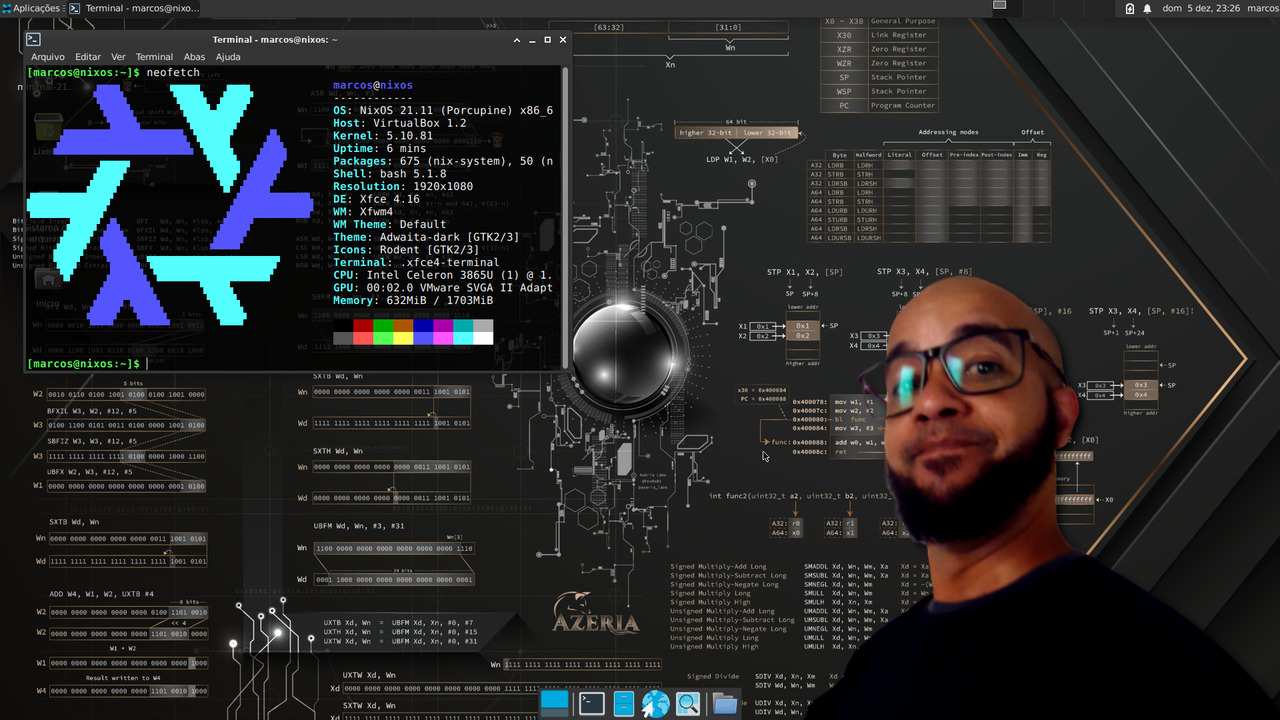
🔊 Nesse vídeo fizemos a instalação do zero do NixOS, sem interface gráfica, e posteriormente configuramos o configuration.nix e instalamos o Xorg e XFCE além de algumas outras dicas.
NixOS é uma distribuição Linux construída sobre o gerenciador de pacotes Nix . Ele usa configuração declarativa e permite atualizações de sistema confiáveis. Duas ramificações principais são oferecidas: versão Stable atual e Unstable seguindo o desenvolvimento mais recente. O NixOS possui ferramentas dedicadas a DevOps e tarefas de implantação.
Assista ao Vídeo
Site oficial do NixOS: https://nixos.org/
Comandos utilizados no vídeo
- PS1
# Pré comandos
sudo loadkeys br-abnt2
export PS1="$(echo $PS1" " | sed 's/^..//g') "
# Manual
nixos-help
# Particionamento
parted -l
parted /dev/sda -- mklabel gpt
parted /dev/sda -- mkpart primary 512MiB -2GiB
parted /dev/sda -- mkpart primary linux-swap -2GiB 100%
parted /dev/sda -- mkpart ESP fat32 1MiB 512MiB
parted /dev/sda -- set 3 esp on
# Formatando
mkfs.ext4 -L nixos /dev/sda1
mkswap -L swap /dev/sda2
mkfs.fat -F 32 -n boot /dev/sda3
# Montagem de dispositivos
mount /dev/disk/by-label/nixos /mnt
mkdir -p /mnt/boot
mount /dev/disk/by-label/boot /mnt/boot
swapon /dev/sda2
# Gerar o o arquivo configuration.nix
nixos-generate-config --root /mnt
# Editar o arquivo, veja exemplo do arquivo abaixo
vim /mnt/etc/nixos/configuration.nix
# Instalar e reiniciar
nixos-install
reboot
# Instalações realizadas
sudo nix-env -iAv nixos.vim
sudo nix-env -iAv nixos.neofetch
Arquivo de configuração configuration.nix
# Edit this configuration file to define what should be installed on
# your system. Help is available in the configuration.nix(5) man page
# and in the NixOS manual (accessible by running ‘nixos-help’).
{ config, pkgs, ... }:
{
imports =
[ # Include the results of the hardware scan.
./hardware-configuration.nix
];
# Use the systemd-boot EFI boot loader.
boot.loader.systemd-boot.enable = true;
boot.loader.efi.canTouchEfiVariables = true;
# networking.hostName = "nixos"; # Define your hostname.
# networking.wireless.enable = true; # Enables wireless support via wpa_supplicant.
# Set your time zone.
time.timeZone = "America/Sao_Paulo";
# The global useDHCP flag is deprecated, therefore explicitly set to false here.
# Per-interface useDHCP will be mandatory in the future, so this generated config
# replicates the default behaviour.
networking.useDHCP = false;
networking.interfaces.enp0s3.useDHCP = true;
# Configure network proxy if necessary
# networking.proxy.default = "http://user:password@proxy:port/";
# networking.proxy.noProxy = "127.0.0.1,localhost,internal.domain";
# Select internationalisation properties.
i18n.defaultLocale = "pt_BR.UTF-8";
console = {
font = "Lat2-Terminus16";
keyMap = "br-abnt2";
};
# Enable the X11 windowing system.
services.xserver.enable = true;
services.xserver.desktopManager.xfce.enable = true;
services.xserver.displayManager.lightdm.enable = true;
# Configure keymap in X11
services.xserver.layout = "br";
# services.xserver.xkbOptions = "eurosign:e";
# Enable CUPS to print documents.
# services.printing.enable = true;
# Enable sound.
# sound.enable = true;
hardware.pulseaudio.enable = true;
# Enable touchpad support (enabled default in most desktopManager).
services.xserver.libinput.enable = true;
# Define a user account. Don't forget to set a password with ‘passwd’.
users.users.marcos = {
isNormalUser = true;
extraGroups = [ "wheel" ]; # Enable ‘sudo’ for the user.
};
# List packages installed in system profile. To search, run:
# $ nix search wget
environment.systemPackages = with pkgs; [
vim # Do not forget to add an editor to edit configuration.nix! The Nano editor is also installed by default.
wget
firefox
];
# Some programs need SUID wrappers, can be configured further or are
# started in user sessions.
# programs.mtr.enable = true;
# programs.gnupg.agent = {
# enable = true;
# enableSSHSupport = true;
# };
# List services that you want to enable:
# Enable the OpenSSH daemon.
# services.openssh.enable = true;
# Open ports in the firewall.
# networking.firewall.allowedTCPPorts = [ ... ];
# networking.firewall.allowedUDPPorts = [ ... ];
# Or disable the firewall altogether.
# networking.firewall.enable = false;
# This value determines the NixOS release from which the default
# settings for stateful data, like file locations and database versions
# on your system were taken. It‘s perfectly fine and recommended to leave
# this value at the release version of the first install of this system.
# Before changing this value read the documentation for this option
# (e.g. man configuration.nix or on https://nixos.org/nixos/options.html).
system.stateVersion = "21.11"; # Did you read the comment?
}Links Úteis
Instalação:
Manual para instalações de pacotes, exemplo XFCE
Mais informação sobre o NixOS na Wikipédia
Manual de como o gerenciador de pacotes Nix funciona
Wallpaper(Papel de Parede) utilizado no vídeo
programacao gnulinux distros sistemasoperacionais so





